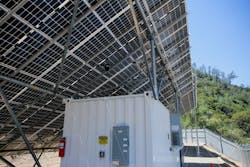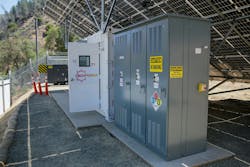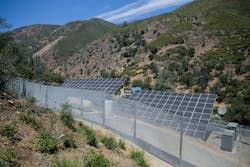PG&E’s Remote Grid Delivers Safety, Savings
According to the National Oceanic and Atmospheric Administration, the frequency of billion-dollar disasters due to climate change has increased by more than five times since the 1980s. Combined with the fact that 60% of U.S. distribution lines are surpassing their 50-year life expectancy, this means grid reliability is at greater risk than ever. Uprooted trees, tree limbs and other debris strewn about by powerful winds, mudslides and flooding resulting from winter storms and hurricanes can knock down poles and power lines, causing long-duration outages that affect vulnerable and rural citizens the most.
Climate change requires utilities to take a proactive, vigilant posture in predicting and preventing damaging wildfires to their equipment. The frequency and severity of extreme weather events and natural disasters are increasing. Additionally, large areas across the West Coast of the U.S. are experiencing dry climates, drought conditions and strong winds. In California alone, 75,000 miles (120,701 km) of overhead lines exist in high fire-threat districts (HFTD). Energy providers have achieved considerable progress in reducing risks within their service areas; however, wildfires ignited by power lines remain a major challenge.
To meet this challenge head on, utilities are spending billions of dollars on distribution grid-hardening initiatives. According to the U.S. Energy Information Administration, distribution spending has increased over 64% since 2000, which is a difference of roughly US$22 billion. Utilities are using a variety of risk-mitigation strategies to tackle this issue, including vegetation management, conductor covering, undergrounding, data analytics, artificial intelligence, machine learning and remote-sensing technology. However, the relative expense of most conventional risk-mitigation wires solutions vs. distributed energy solutions in remote areas has created a new opportunity.
Briceburg Fire Of 2019
Situated amid the rugged landscapes of Briceburg, California, residents have long contended with the risks associated with natural disasters, which routinely challenge the resilience of local infrastructure. Since June 2021, Briceburg has witnessed a paradigm shift in energy reliability, marked by the advent of a groundbreaking solution that has consistently demonstrated resilience against the forces of nature, at a cost lower than traditional grid infrastructure.
In 2019, the Briceburg Fire decimated the power lines that served Briceburg, prompting a critical reassessment of infrastructure solutions. The historical line route was challenging to rebuild through the last 1.4 miles (2.3 km) of rugged, HFTD terrain. Additionally, conventional alternatives, such as hardened overhead lines and underground lines, were not only costly but also posed feasibility challenges given the location.
This predicament led to collaborative work between Pacific Gas & Electric Co. (PG&E) and BoxPower, whose software and hardware solutions focus on optimizing the performance and accelerating the deployment of solar-plus-storage microgrids. Their collaboration culminated in the implementation of a remote grid system that operates stand-alone from the centralized grid and permanently replaces existing distribution lines. This system was designed and engineered to withstand the diverse array of environmental challenges, thereby ensuring year-round reliable power supply to the residents of Briceburg. The objective transcended mere power supply continuity; it aimed at fortifying grid resilience and aligning with California SB100’s mandate to reduce greenhouse gas emissions, targeting 100% renewable electricity by 2045.
Solar Plus Storage
For this project, BoxPower developed a dual solar array — one ground-mounted array and one container-mounted array — with a nominal photovoltaic power of 36.5 kW and a 69.12-kWh lithium-iron-phosphate battery bank.
The system can deliver up to 27.2 kW of continuous power output with a surge capacity of up to 48 kW. Additionally, it incorporates two integrated 35-kVA propane prime power generators as a backup and features a fire-suppression system, a crucial component in this high fire-risk area. Both PG&E and BoxPower can remotely monitor and control the system by satellite, ensuring performance monitoring, reporting and automated propane delivery capabilities.
Resilience And Reliability
Since its commissioning in June 2021, the Briceburg remote grid has been a testament to resilience and steadfast reliability, maintaining 99.9999% power reliability through September 2023, with only 16 seconds of total downtime for the five customers it serves.
The stand-alone power system has generated 94% of its power from renewable sources, with the solar and battery components being the primary sources and only 6% emanating from the integrated dual propane generators mostly during winter. PG&E and BoxPower’s design consideration to integrate backup generators was pivotal, ensuring redundancy and guaranteeing uninterrupted off-grid power 24/7/365, a feature particularly crucial during the winter months when solar generation is inherently reduced due to shorter days and cloudier weather.
The Briceburg system’s operation during extreme weather events exemplifies its unmatched resilience. It remained operational without issues during a historic winter storm in December 2021 and weathered an August 2021 heatwave seamlessly. Moreover, during the 2021 Oak Fire, with a wildfire raging just a few miles away and PG&E proactively shutting down power to the entire area, the Briceburg stand-alone power system stood as an exception, continuously and safely powering PG&E customers, including two residences, a visitor center, and telecommunications and transportation facilities.
Financially, the remote grid solution has provided PG&E substantial savings compared to the alternative of reconstructing the previously destroyed distribution lines. The estimated cost of distribution line rebuilds and system hardening efforts can reach millions of dollars per mile. Remote grids are intended to meet customer needs at lower lifetime costs and a significantly lower risk of fire than conventional
solutions in targeted rural locations.
More Remote Grids
PG&E’s collaboration with BoxPower and other microgrid vendors heralds a transformative era in energy infrastructure, with the successful Briceburg initiative serving as a stepping stone.
As of November 2023, PG&E has four additional stand-alone power systems in operation, for a total of five operational systems. It plans to deploy up to 30 systems through 2026. PG&E has identified hundreds of potential locations for remote grids across its California service area, highlighting the adaptability of this innovative solution across various environments. The utility is engaging with customers who reside in high fire-threat areas to provide a clean and wireless alternative to traditional grid power.
These remote grids are expected to provide better levels of electric reliability, significantly reducing service interruptions caused by weather and public safety power shutoff events. The community will also benefit from reduced greenhouse gas emissions since the solar-with-propane backup system provides up to an estimated 89% renewable energy.
PG&E is committed to redefining traditional grid infrastructure and miti-gating wildfire risks through the removal of overhead power lines, while simultaneously enhancing service reliability. The strategic development of remote grids signals a promising future in addressing utility-related challenges and advancing renewable energy solutions.
Andrew Mulherkar is a product manager on the remote grid team at Pacific Gas & Electric Co. (PG&E), where he focuses on strategy and project development. Prior to PG&E, Mulherkar worked on
grid modernization and utility evolution in roles at Bidgely, Southern Co. and Greentech Media. Mulherkar holds an MBA degree from Yale University and bachelor’s degrees from Tufts University and New England Conservatory.
Noa Schachtel ([email protected]) is marketing coordinator at Grass Valley, California-based BoxPower, which designs, deploys and scales stand-alone plug-and-play solar-plus-storage microgrid power systems. Schachtel focuses on marketing strategy, research and asset enablement. He gained his experience working for multiple start-ups, including EVmatch and Sourcefit. Originally from Honolulu, Hawaii, Schachtel graduated with a degree in philosophy and ethics from Claremont McKenna College, in Claremont, California, where he also served as a fellow at the Center for Innovation and Entrepreneurship and as an analyst at the Roberts Environmental Center.
About the Author
Andrew Mulherkar
Andrew Mulherkar (Product Manager, Remote Grids at PG&E): Andrew is a product manager on the Remote Grid team at PG&E, where he focuses on strategy and project development. Prior to PG&E, Andrew worked on grid modernization and utility evolution in roles at Bidgely, Southern Company, and Greentech Media. Andrew holds an MBA from Yale University and bachelor’s degrees from Tufts University and New England Conservatory.
Noa Schachtel
Noa Schachtel is Marketing Coordinator at Grass Valley, Calif.-based BoxPower, which designs, deploys and scales standalone plug & play - solar + storage microgrids power systems. Noa’s focuses is on marketing strategy, research and asset enablement. Noa gained his experience working for multiple startups including EVmatch and Sourcefit. Originally from Honolulu, Hawaii, Noa graduated with a degree in philosophy and ethics from Claremont McKenna College, in Claremont, California, where he also served as a fellow at the Center for Innovation and Entrepreneurship, and an Analyst at the Roberts Environmental Center.




